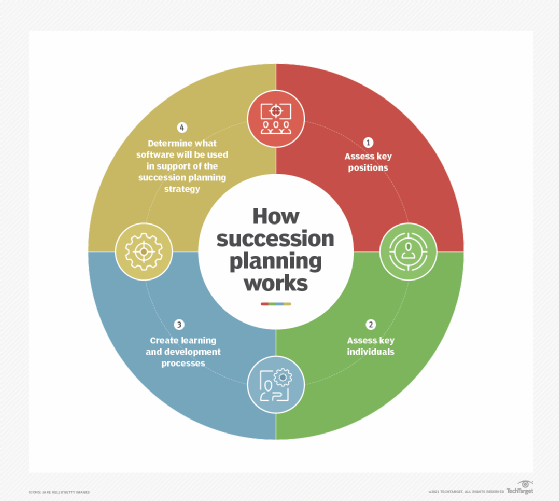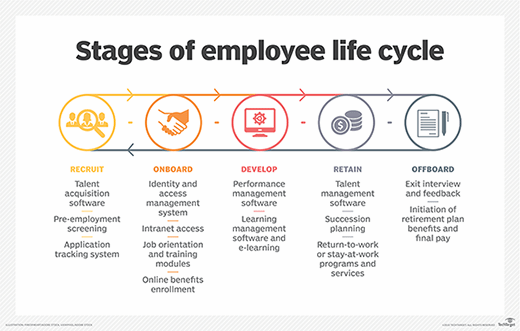succession planning
What is succession planning?
Succession planning is the strategic process of identifying and developing internal candidates to fill key organizational roles to ensure business continuity and leadership in the face of role transitions, departures, or unforeseen events. It is relevant to all companies, large or small, for-profit or nonprofit.
The planning process is meant to create a talent pipeline of successors that will keep the organization running with little to no interruption when inevitable staff changes occur.
Effective succession planning works by assessing staffing needs that might arise and creating long-term goals and strategies, including leadership development, to manage those gaps.

Integration of succession planning with other HR processes
HR departments, sometimes called the human resources management (HRM) department or human capital management (HCM), are typically a key driver in succession planning, although support from top leadership and other stakeholders is critical to success.
Succession planning is intricately linked with other HR processes, such as performance management, learning and development, and workforce planning. This integration ensures a holistic approach to talent management, where performance data feeds into succession planning, development plans are tailored to prepare successors, and workforce planning informs the strategic direction of succession efforts.

The strategic importance of succession planning
Succession planning ensures that a business can continue running smoothly after an important role becomes vacant. An organization might want a succession plan to retain internal company knowledge, identify skill gap needs for training, and to invest in employees. The process helps identify employees with the right skill sets and talent that can fill the vacant position.
In a narrow context, succession planning refers to replacing the CEO or executive director. In the event a higher position like a CEO suddenly becomes vacant, a succession plan ensures that there is already a method in place to replace that role. It gives an organization time to prepare candidates with high potential to fill that role. During this time, potential candidates are evaluated, strengths and knowledge gaps are identified, and the candidate receives training in needed areas.
When used in a more expanded sense, the term can refer to replacing board members, key leaders or the C-suite.
Succession plans should also fit into larger strategic visions, ensuring that future leaders are prepared to drive the organization's strategic vision forward. This alignment helps in building a leadership team that is competent in operational execution as well as strategic thinking and long-term planning.
While the top executive is a key factor in a company's performance, taking a wider lens to the concept of succession planning is increasingly seen as critical, particularly given the current challenges associated with talent management in companies today.
Succession planning for small businesses and startups
Small businesses and startups often face distinct succession planning challenges due to a limited internal talent pool. For these entities, it's crucial to focus on external talent acquisition strategies, develop partnerships with educational institutions for talent development, and consider the broader ecosystem of mentors and industry networks to support leadership continuity.
What are the benefits of succession planning?
When an employee leaves, there is a ripple effect. It might be most evident when the key leader leaves, but the hole created when an employee leaves his or her position can be profound, even at lower levels. Replacing employees can be a difficult task, especially in industries with noted talent shortages and skills gaps.
It can be a lengthy process to onboard a replacement employee and get them to full productivity. A lack of planning can especially damage smaller and family businesses, which often don't have surplus candidates to choose from.
The need for succession planning relates closely to its benefits. Here is a summary of the benefits:
- Succession planning helps save time and cost. The time needed to find an employee's replacement will cost time and money and hamper productivity
- With more baby boomers retiring, succession planning helps ensure there are more employees available with the skill set to replace senior executives.
- When a candidate-driven market exists, companies compete for a scarcity of talent, which typically makes hiring desired candidates more difficult. Choosing internal employees to fill vacant critical roles helps alleviate this problem.
- Succession planning helps an organization create a better reputation as a talent destination. It boosts employee engagement through career development and makes workers feel valued.
- If skilled employees can immediately fill needed high-level roles, business operations can continue with uninterrupted excellence.
- It helps to align HR and the vision for an organization, and supports HR and managers in creating and supporting proactive programs.
- Supervisors mentor employees, transferring their expertise.
- Management keeps better track of potential valuable employees.
How does the succession planning process work?
Depending on the size of the organization and its goals, strategic planning for the succession planning process can vary widely. However, fundamentals include the following:
- Gaining the support of key stakeholders, including the CEO or executive director.
- Assessing key positions (and individuals) and deciding which ones to focus on.
- Identifying high-potential employees for key leadership positions and creating learning and development plans tailored to a wider range of employees for more expansive succession plans.
- Assessing the extent to which internal candidates can fill roles (likely with development), who will be more familiar with company culture and processes, and which roles HR should look externally for the right talent pool.
- Creating effective learning and professional development processes that support the succession strategy, especially experiential development such as job shadowing and cross-functional moves.
- Determining which HR software will be used in support of the succession planning strategy and process.
Succession planning in global and remote work environments
The COVID-19 pandemic significantly impacted succession planning, highlighting the need for robust strategies to address the abrupt absence of key personnel and ensure business continuity in unpredictable circumstances, such as a sudden shift from in-person to remote work.
Global and remote work environments pose unique challenges for succession planning, such as cross-border talent management and developing leaders who can lead virtual teams effectively.
To address these challenges, forward-thinking businesses are leveraging technology for virtual leadership development programs and ensuring that succession plans are adaptable to accommodate the nuances of managing a geographically dispersed workforce.
Additionally, the use of advanced HR analytics and machine learning has become pivotal in identifying potential successors and predicting future leadership gaps in a dispersed workforce.
Tools like SAP SuccessFactors, Oracle HCM Cloud, and Workday provide sophisticated analytics capabilities, allowing organizations to assess talent potential, performance, and readiness systematically, facilitating more informed succession decisions.
Best practices for succession planning
Here are some succession planning best practices to follow:
- Be proactive. Prepare for unforeseen instances where a high-level executive suddenly leaves. This way, an organization can keep operating as normal.
- Clarify the roles included in the succession plan. Communicate the positions and the people involved in the plan. Decide if the positions included will be the CEO or will include other C-suite positions.
- Engage stakeholders in the process. HR should not oversee everything; HR should enable the process and provide necessary tools.
- Don't exclusively choose the employee closest in rank to the role that needs to be filled. Other promising employees should be chosen if their skills are optimal.
- Start backward. Before training an employee to fill a specific role, begin by defining the core skills, abilities and competencies needed.
- Train successors with mentors and job rotations. Having a supervisor act as a mentor allows the mentor to transfer expertise and gives employees more knowledge of certain roles and experiences.
- Give regular feedback. Include evaluations of those who need to be developed further.
- Create individual development plans. This way, employees receive the specific attention they need to develop any required skills. Managers should also give continual feedback.
- Have trial runs. A trial run is when a potential successor assumes some of the responsibilities of the role they are inheriting. This practice will allow the successor to gain valuable experience.
Succession planning should be on the radar of every organization because it can mitigate disruptions when employees leave or are promoted as part of the employee lifecycle.

Different uses of the term succession planning
It's important to note that succession planning is often used narrowly in reference to the CEO or executive director, or slightly more expanded to include board members, key leaders or the C-suite.
However, extending the concept of succession planning to a broader range of employees is gaining widespread traction, especially through the use of HR software, generally, or talent management software, specifically. Succession planning might also be used to indicate the passing of company ownership onto employees.
Real-world succession planning example
For several years before Steve Jobs stepped down as CEO of Apple in 2011, he had groomed his successor Tim Cook to take the top leadership role. This included Cook working a wide range of operational roles and directly with Jobs for CEO-specific experience. Cook also stepped in to lead daily operations twice when Jobs was on sick leave.
Besides creating a succession plan for the top leadership role, Jobs also founded Apple University in 2008 to provide a leadership curriculum based on Jobs's experiences and business savvy.
Succession planning can help companies in various ways, including reducing business disruption and recruitment costs. Learn more about the benefits of succession planning. Also, read more about different key aspects of a succession planning strategy.






